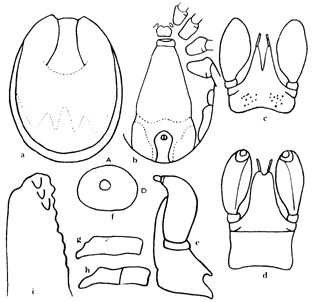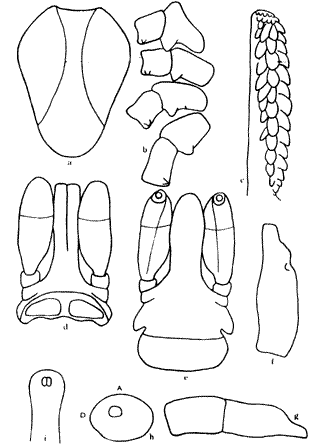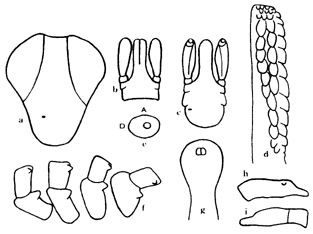IXODES KOHLSI Arthur
from Roberts FHS (1960): A systematic study of the Australian species of the genus Ixodes (Acarina: Ixodidae). Australian Journal of Zoology 8:392-485.
Ixodes percavatus Tubb. 1937, pp. 416-18 (not I. percavatus Neumann, 1906); ? 1938. pp. 346 (not seen).
Ixodes kohlsi Arthur, 1955a, pp. 18-21, pl. 1, figs. 2-14, pl. 4, figs. 15---2I. Mykytowycz and Hesterman, 1967, p. 165.
Male
Fig. 5, a-i
Diagnosis
A dark, medium-sized, oval tick with a prominent, raised, marginal body fold; scutum with fine punctations; capitulum short, basis with posterior margin elevated, no cornua, and followed by an elongate "neck"; palpal articles 2 and 3 inclined ventrad; hypostome conspicuously indented apically with outer margins serrated and 2-3 teeth distally; anal plate elongate and constricted posteriorly; coxae with terminal rounded ridge; tarsi curved ventrad distally.

Fig. 5-I. kohlsi, male: a, body (dorsal view); b, body (ventral view); c, capitulum (dorsal view); d, capitulum (ventral view); e, palp (lateral view); f, spiracular plate; g, tarsus 1; h, tarsus IV; i, hypostome.
Description
Body.-Oval, dark, 3-5-3.8 mm by 2.6-3.2 mm; marginal body fold wide and conspicuous in the flat, older specimens, ill defined or absent in the thick-bodied newly emerged specimens; numerous short, stiff hairs.
Capitulum.-Length 0.53-0.57 mm; resting on an unusually elongate and parallel-sided "neck", basis dorsally 0.43 mm wide, with 2 groups of punctations, posterolateral margins straight and slightly divergent anteriorly, posterior margin elevated and concave, with broadly rounded posterolateral angle, but without cornua; basis ventrally with posterior margin a little concave, the lateral margins straight, palpiger bearing article 1 projecting a little laterally; palpi short and broad with numerous bristles and s row of median bristles ventrally on articles 2 and 3, article 1 rounded, wider than long, articles 2 and 3 indistinctly separated, 0.31-0.34 mm long, narrow at base, and widening at mid-length to a maximum width of 0.18 mm, curving ventrad apically with article 4 directed anteroventrally.
Hypostome 0.25 mm long, broad at base and narrowing apically where it becomes strongly indented; dentition reduced to serrations on the outer margins and to 2-3 small teeth apically.
Scutum.-Oval, 3.1-3.4 mm by I. 7-2.3 mm, convex, glossy, with depressed areas laterally and in median third; pseudoscutum faintly visible; punctations fine, more numerous laterally and posteriorly; cervical grooves well defined, attaining, or almost so, the posterior margin of pseudoscutum; no lateral carinae; emargination moderate; scapulae rounded; hairs few and short; degree of sclerotization variable as shown in Figure 5a, and in plate II, figures 16-18, of Arthur (1955a).
Genital aperture.-In second intercoxal space or at level of posterior margin of coxa II.
Ventral plates.-Pregenital plate hexagonal with a small notch anteriorly and with a small oval or crescent-shaped plate on either side anteriorly; other plates irregularly sclerotized (this may be because the males examined were newly emerged and may not have hardened), as in Figure 5b, and also plate II, figure 19, A-C, of Arthur (1955a), the margins of the median and adanal plates ill defined; anal plate rounded in front, constricted behind; numerous, short, pale hairs.
Spiracular plate.-Broadly oval, the longer axis transverse, 0.28 by 0.33 mm.
Legs.ong and well furnished with relatively long, pale bristles; coxae convex, glossy, unarmed, with shallow rounded ridges distally; tarsi slender, narrowing somewhat abruptly apically, the apices directed ventrad; tarsus I 0.62-0.65 mm in length, tarsus IV, 0.72-0.80 mm in length.
Female
Fig. 6, a-i
Diagnosis
Thickly clothed with hairs (unfed specimens), scutum widest anteriorly; capitulum with posterior margin of basis elevated, and with shallow, rounded cornua, porose areas large, auriculae present; palpi short; hypostome mainly 3/3, becoming 2/2 basally with the median ventral area almost completely unarmed; anal grooves constricted behind; all coxae with external spur; coxa 1 also with broad internal spur; all trochanters with external spur; tarsi tapering rather abruptly.
Description
Body.-Unfed specimens 2.5-2.8 mm by 1.8-2.1 mm, broadly oval and widest just behind coxa IV, with numerous, pale, decumbent hairs and with 4 festoon-like structures posteriorly due to extension dorsally of anal and genital grooves; engorged specimens 8.2-9.6 mm by 4.5-5.2 mm, posterolateral grooves elongate, median groove short; hairs scattered.
Capitulum.-length 0.73-0.78 mm; basis dorsally convex, 0.57-0.63 mm wide, posterior margin elevated, particularly medianly, with broad, shallow, rounded cornua, posterolateral margins divergent anteriorly and curved; porose areas transversely oval, depressed, large, the interval narrow; basis ventrally with the posterior margin convex, strongly constricted behind the auriculae, which are large, rounded, and directed posterolaterally; palpi short and broad, rounded apically, article 1 rounded about as long as broad, articles 2 and 3 with suture indistinct but apparent, 0.43-0.48 mm long, constricted at base and broadening rapidly to attain a maximum width of a little more than one-third the length, article 3 0.16-0.20 mm. long with some long bristles apically.
Hypostome about 0.43-0.51 nim long, the apex rounded, the sides subparallel, a ventral median unarmed area extending for practically the entire length; dentition 1 row of 6/6, 1-2 rows of 5/5, 1-2 rows of 4/4, 5-6 rows of 3/3, and 6 rows of 2/2.

Fig. 6-I. kohlsi, female: a, scutum; b, coxae and trochanters; c, hypostome; d, capitulum (dorsal view); e, capitulum (ventral view); f, tarsus 1; g, tarsus IV; h, spiracular plate; i, anal grooves.
Scutum.-Suboval, 1 - 2-1.6 mm by 0 - 9-1 . 1 mm, longer than wide and widest anteriorly, median fields convex, anterolateral margins convex, posterolateral margins slightly sinuous, posterior angle broadly rounded; punctations fine medianly, rugose laterally; cervical grooves deep, short, and converging anteriorly, continuing posteriorly as broad, divergent, shallow depressions to attain the posterior margin; no lateral carinae; emargination almost obsolete, scapulae very shallow, rounded; hairs few and mainly towards anterior and anterolateral margins.
Genital aperture.-Usually in the second intercoxal space, but sometimes level with the posterior margin of coxa II.
Anal grooves.-Rounded in front and in unfed and little fed specimens strongly constricted behind, but in engorged specimens the constriction less prominent.
Spiracular plate.-Broadly oval, the longer axis transverse, 0.24-0.30 mm by 0.30-0.36 mm.
Legs.--ong and dark with pale articulations; coxae convex, smooth, coxa I with a broad, rounded, shallow internal salience, coxae II and III frequently also shallowly salient internally, all coxae with well-developed external spurs, that on coxa I being the largest and most acute; all trochanters with a well-defined external spur, strongest on trochanters II and III and sometimes much reduced on trochanter IV; tarsi ending somewhat abruptly, tarsus I 0.66-0.80 mm long, tarsus IV 0.70-0.86 mm long.
Nymph
Fig. 7, a-i
Diagnosis
Scutum and capitulum as in the female; hypostome mainly 3/3, becoming 4/4 apically, and 2/2 basally; coxae, trochanters, and anal grooves as in the female.
Description

Fig. 7.- I. kohlsi, nymph: a, scutum; b, capitulum (dorsal view); c, capitulum (ventral view); d, hypostome; e, spiracular plate; f, coxae and trochanters; g, anal grooves; h, tarsus I; i, tarsus IV.
Body.-Oval, broadly so in unfed specimens, unfed nymph 1.27 by I.03 mm, engorged nymph to 3.9 by 3.0 mm; many decumbent, pale hairs.
Capitulum.-length about 0.38 mm; basis dorsally about 0.28 mm wide, somewhat rectangular, the posterior margin elevated with shallow, raised cornua; basis ventrally rounded posteriorly, auriculae present as small, salient lobes; palpi as in female.
Hypostome about 0.24 mm long, dentition 5/5 and 4/4 distally of small teeth, then-5A rows of 3/3, and 5 rows of 2/2.
Scutum.-Shape and cervical grooves as in female, 0.61-0.64 mm by 0 -49-0.50 mm; glossy; punctations few and fine; some pale hairs.
Anal grooves.-As in female.
Spiracular plate.-Broadly oval, the longer axis transverse, 0.11-0.13 mm by 0.15-0-17 mm.
Legs.-Coxae and trochanters with spurs as in female; tarsi tapering somewhat abruptly, tarsus I 0.35 mm in length, tarsus IV 0.38 mm in length.
Larva
Fig. 8, a-g
Diagnosis
Shape of scutum m in female; capitulum with rectangular basis, the ~or margin elevated, with shallow cornua; hypostome dentition mainly 313, basally 2/2; coxae and trochanters with spurs as in female; tarsi tapering somewhat abruptly.
Description
Fig. 8- I. kohlsi, larva: a, coxae and trochanters; b, scutum; c, hypostome; d, basis capituli (dorsal view); e, tarsus I; f, tarsus IV; g, basis capituli (ventral view)
Body.-Oval, broadly so in unfed larvae; unfed larvae 0.60 by 0.51 mm, engorged larvae 1.74 by 1.21 mm.
Capitulum.-Length about 0.21 mm; basis dorsally rectangular, 0.14 mm wide, posterior margin straight, elevated, with shallow raised cornua; basis ventrally rounded posteriorly, no apparent auriculae; palpi slender, articles 2 and 3 with no distinct suture, 0.14 mm long, narrow at hue, rounded apically.
Hypostome rounded apically, dentition mainly 3/3, 2/2 basally and 4/4 distally, about 10 large teeth in outer and middle files.
Scutum.-Shape as in female, 0.32 by 0.22 mm, some pale hairs.
Anal grooves.-Indistinct, but appear subparallel posteriorly.
Legs.-Coxae and trochanters as in female; tarsi tapering somewhat abruptly; tarsus I 0.17-0.20 mm in length, tarsus IV 0.18-0.20 mm in length.
Hosts and Distribution
This species seems to be the common tick on the little penguin, Eudyptula minor, on Australian shores. The specimens examined by Arthur (1955a), and from which he described the species, were taken from this host or from its nests at Robe, S. Aust., and on Lady Julia Percy L, Vic. It has also been recorded from E. minor on Montagu L, N.S.W., by Mykytowycz and Hesterman (1957).
Material examined- NEW SOUTH WALES: under stones, Five Islands Group, 13.iii.1936, 5 E E ; E. minor, Five Islands Group, 7.iii.1959, 7 E E ; E. minor, Five Islands Group, 7.xi.1959, 3 E E ; E. minor, Five Islands Group, 12.xi.1955, 1 q; E. minor, Tollgates L, Wxi.1959, 2 E E ; man (attached), Tollgates L, 25.xi.1959, 1 o; crawling on tent, Tollgate L, 6 oo; E. minor, Tollgates L, 2 E E . VICTORIA: E. minor (on body and in nest), Lady Julia Percy L, February 1937, 2 G G , 6 E E , 18 oo; Lady Julia Percy L, 1 G , 2 E E , numerous bred larvae; "fairy penguin", Phillip L, 15.ii.1959, 5E E ; E. minor, Williamstown, 2.vii.1948, 5oo. SOUTH AUSTRALIA: locality and date illegible, 8E E ; "penguin", Greenly L, 7-16.xii.1947, 3E E ; Phalacrocorax fuscescens, 1 E . TASMANIA: E. minor, Kingston Beach, 10.x.1951, 1G , lE , 5 larvae; "penguin", North Bruny L, 8.iii.1940, 6 E E .
Fig. 8-L kohlsi, larva: a, coxae and trochanters; b, scutum; c, hypostome; d, basis capituli (dorsal view); e, tarsus I; f, tarsus IV; g, basis capituli (ventral view).
The above specimens from Lady Julia Percy I. and also Arthur's specimens from this locality were collected by Tubb (1937) who identified them as I. percavatus. Tubb in his description mentioned that specimens were also taken from the nests of the mutton-bird, Puffinus tenuirostris, "but only where the penguin nesting ground overlapped that of the mutton-bird." He found that young and moulting penguins often carried adults, nymphs, and larvae, but only nymphs and larvae occurred on fully fledged birds. What was probably I. kohlsi was also recorded by Tubb (1938) from E. minor, Langton L, S.Aust.
According to Mykytowycz and Hesterman (1957), this tick occurs mainly on the head of its host, where it cannot be removed by preening.
Comments
Arthur (1955a) in describing I. kohlsi gave detailed descriptions of the male and nymph, but was content to compare the female with I. rothschildi and to list the differences between them. These differences are in the dentition and its distribution, the Shape of the anal grooves, the position of the genital aperture, the shape of the tarsi, and in the structure of Haller's organ.
The specimens seen by the author from E. minor, Lady Julia Percy L, J. A. Tubb, are undoubtedly portion of the material examined by Arthur (1955a) and from which he selected his types. The males and nymphs agreed very closely with the descriptions given by Arthur (1955a). There are, however, some differences in the descriptions of the female given by the author and that published by Arthur (1955a) and based on his description of I. rothschildi (Arthur 1953). These differences lie mainly in the degree of development of the emargination of the scutum, the absence of lateral carinae, and in the armature of the coxae.
I. kohlsi is very close to I. eudyptidis, but the female of the latter species may be readily distinguished by the absence of cornua, by the more strongly elevated posterior margin of the basis capituli, by the usually conspicuous indentation at the inner junction of palpal articles 2 and 3, by the more pointed internal spur on coxa I, by the milder constriction in the anal grooves, and by the dentition.
The Paralysis Tick of Australia - Home
E-mail Us to report a broken link!